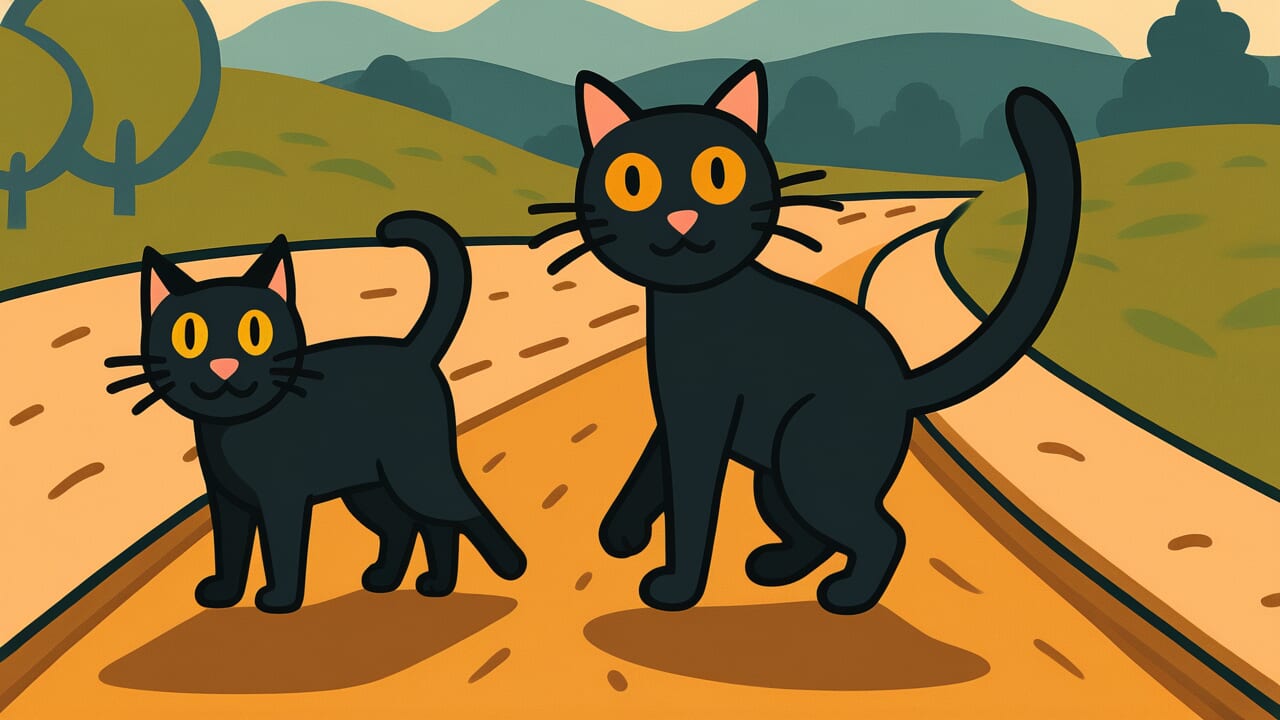How to Read “A stray cat’s side-walking”
のらねこのとなりあるき
Meaning of “A stray cat’s side-walking”
“A stray cat’s side-walking” is a proverb that describes lazy people who skip their real work and wander around aimlessly.
It compares idle behavior to how stray cats roam freely without any set job or purpose.
This proverb is mainly used to criticize working-age people who abandon their responsibilities and waste time wandering.
It has been used to warn people who stroll around town or spend time idly with friends when they should be working hard from morning to night.
Even today, you can use it to describe someone who goes out to distract themselves instead of working on an approaching deadline.
It also applies to people who put off what they should do and play around instead.
Through the concrete image of a stray cat, this proverb vividly portrays someone drifting aimlessly and wasting time.
Origin and Etymology
No clear written records exist about the origin of “A stray cat’s side-walking.”
However, we can make interesting observations from the words themselves.
First, let’s focus on the existence of “stray cats.” From the Edo period through the Meiji era, stray cats were familiar creatures lurking around people’s living areas.
Unlike house cats, they had no set job and spent all day living freely as people watched.
The expression “side-walking” is also interesting. It doesn’t simply mean “walking beside.”
It likely carries the meaning of following along with the stray cat’s free and carefree lifestyle.
It probably expresses how someone drifts and plays around, escaping from responsibility like a stray cat, even though they have work to do.
In farming villages and merchant society, diligence was considered a virtue. Laziness was strictly condemned.
Within these values, the free image of stray cats was probably adopted into people’s language as a symbol of lazy people.
It likely emerged as an expression to warn people who skip work and play around by comparing them to stray cats.
Usage Examples
- That person only does a stray cat’s side-walking, so who knows when they’ll actually start working
- With exams coming up, this is no time for a stray cat’s side-walking
Universal Wisdom
“A stray cat’s side-walking” reveals a universal human trait: the temptation to escape.
Why do people turn away from what they should do and wander around playing instead?
The answer lies deep in the human heart. Responsibility and duty place pressure on us.
The desire to be freed from that weight, even temporarily, is an emotion humans have carried across time.
The longing for a free and carefree existence like a stray cat symbolizes exactly this release from pressure.
But our ancestors also understood that this temporary escape ultimately causes suffering.
Time spent skipping work and playing around may look fun on the surface.
Yet guilt and anxiety swirl at the bottom of the heart.
What you should do doesn’t disappear. Rather, it weighs heavier as time passes.
This proverb has been passed down because it perfectly captures a conflict everyone experiences.
It describes the temptation of “I want to take it easy now” and the conscience saying “but that’s wrong.”
Through the familiar image of a stray cat, it teaches us about human weakness and the need to overcome it.
When AI Hears This
When a stray cat walks beside a human, it’s actually performing advanced distance calculations.
In animal behavior science, the boundary where animals flee is called “flight distance.”
For wild animals it’s dozens of meters, for fully domesticated animals it’s zero.
Stray cats fall in between, maintaining roughly 2 to 5 meters.
What’s interesting is that this distance represents “the position of maximum benefit.”
Too close to humans risks capture, too far means missing chances for food.
Stray cats instinctively calculate the optimal distance by weighing risks and returns.
This is exactly what economics calls the “risk-return curve.”
Even more noteworthy is that this distance isn’t fixed.
Meeting the same human repeatedly shortens the distance, while bad experiences instantly widen it.
Stray cats accumulate past data and continuously update the optimal distance for each person.
In human relationships too, getting too close increases conflicts, while staying too distant prevents cooperation.
A stray cat’s side-walking is a model “dynamic distance adjustment system” for gaining benefits without breaking relationships.
Here lies a biological truth: trust is maintained only with a certain distance.
Lessons for Today
“A stray cat’s side-walking” teaches modern you the importance of strength to resist the temptation to escape.
In modern society, smartphones, social media, and streaming services offer incomparably more ways to escape work than before.
Modern versions of “a stray cat’s side-walking” temptations overflow around you.
But this proverb isn’t just scolding you to “don’t be lazy.”
Rather, it teaches the importance of listening to your own heart’s voice.
When you want to wander around, it might be a sign your heart is tired.
What matters is distinguishing between planned rest and aimless escape.
If you truly need rest, take it proudly.
But running away from what you should do only hurts yourself in the end.
Do today what you can do today. That accumulation brings you true freedom and peace of mind.
Freedom like a stray cat’s looks attractive, but the liberation after fulfilling responsibility is true freedom.



Comments